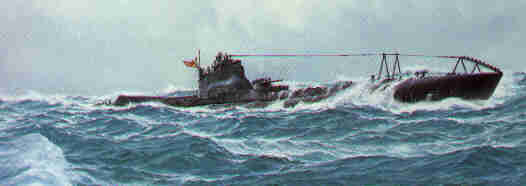SENSUIKAN!

HIJMS Submarine I-70: Tabular Record of
Movement
© 2001-2010 Bob Hackett & Sander Kingsepp
Revision 1
9 November 1935:
I-70 is completed at the Sasebo Navy Yard and registered in the Kure Naval District.
November 1941: Operation Z:
I-70 is in Vice Admiral Shimizu Mitsumi's (former CO of ISE) Advance Expeditionary Force (Sixth Fleet) with Rear Admiral (later Vice Admiral) Miwa Shigeyoshi's (former CO of CL KINU) SubRon 3 in Captain (Rear Admiral, posthumously) Nakaoka Nobuki's (later CO of ATAGO) SubDiv 12 with I-68 and I-69. Cdr Sano Takao (former CO of RO-28 and I-63) is the Commanding Officer.
Admiral Shimizu convenes a meeting of all his commanders aboard his flagship, light cruiser KATORI. Cdr Sano and the other commanders are briefed on the planned attack on Pearl Harbor.
11 November 1941:
I-70 departs Saeki.
20 November 1941:
Arrives at Kwajalein. Refuels and reprovisions.
23 November 1941:
Departs Kwajalein for Hawaii.
2 December 1941:
The coded signal "Niitakayama nobore (Climb Mt. Niitaka) 1208" is received from Combined Fleet. It signifies that hostilities will commence on 8 December (Japan time).[1]
7 December 1941: The Attack on Pearl Harbor:
SubRon 3's mission is to reconnoiter and attack any ships that try to sortie from Pearl Harbor. SubDiv 12 is assigned to patrol between 25 and 50 miles S of Oahu. I-70 is stationed 10 miles from the entrance to Pearl Harbor. At midnight, she fails to answer the radio call sent by KATORI.
8 December 1941:
4 miles SE of Diamond Head, Oahu, Hawaii. Cdr Sano reports an American carrier arriving at Pearl Harbor. (This is USS ENTERPRISE (CV-6). This is the last signal received from I-70.
10 December 1941:
I-6 reports sighting a LEXINGTON-class aircraft carrier and two cruisers heading NE. Vice Admiral Shimizu in KATORI at Kwajalein orders SubRon 1 and other boats to pursue and sink the carrier.
121 miles NE of Cape Halava, Molokai, Hawaiian Islands. In the morning, Ensign Perry Teaff's Douglas SBD-2 "Dauntless" dive bomber of VS-6 from ENTERPRISE attacks I-70 on the surface and disables her so that she cannot submerge. In the afternoon, while I-70 is still running on the surface, she is attacked by an SBD of VS-6 flown by Lt (jg) Clarence E. Dickinson. The submarine upends and sinks at 23-45N, 155-35W, leaving four sailors in the water who later perish. I-70 is the first Japanese combatant ship sunk by United States aircraft during World War II.
Sixth Fleet's headquarters tries to contact I-70, even after the other subs of her division return to Kwajalein. The effort is unsuccessful. I-70 is presumed lost with all 93 hands off Hawaii.
15 March 1942:
Removed from the Navy List.
Authors' Notes:
[1] Mt. Niitaka, located in Formosa (now Taiwan), is then the highest point in the Japanese Empire.
Thanks go to Dr. Higuchi Tatsuhiro of Japan.
– Bob Hackett and Sander Kingsepp.
Back to Submarine
Page





